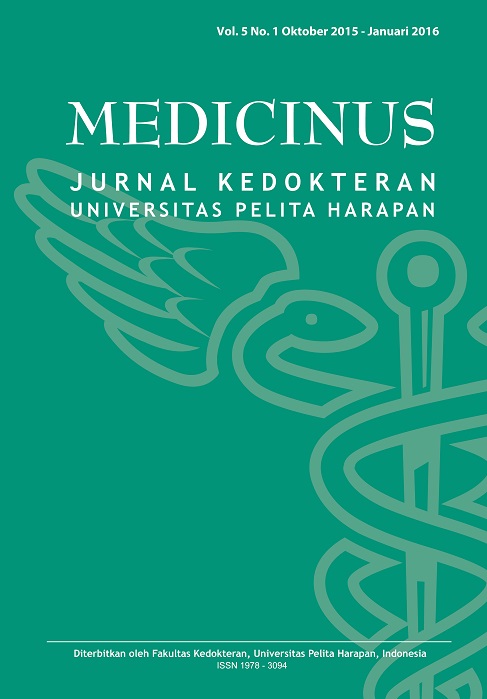Pengaruh P53 Dan YY1 Terhadap Terjadinya Kanker Serviks
DOI:
https://doi.org/10.19166/med.v5i1.1177Abstract
Cervical cancer is one of the most prevalent cancer in the world and caused by Human Papilloma Virus (HPV). The pathogenesis of cancer as whole (50%) is caused by gene mutation. HPV stimulates carcinogenesis on cervix epitel cells by HPV-Encoded viral oncoproteins, E6 and E7, which will inhibit tumor suppressor gene activation, such as p53 gene. HPV-encoded E6 oncoprotein is able to directly attached on p53 causing degeneration via E6-AP-mediated ubiquitination pathway. Moreover, overexpression on YY1 gene has significant role on the progression of HPV on cervical cancer. YY1 inhibits p53 activation dan inhibits apoptosis on cells infected by HPV. Overexpression of YY1 induces reduction of endogenous p53, which will inhibit p53 function as tumor suppressor gene.
Keywords: cervical cancer, HPV, P53, YY1
References
Mohar A, Frias-Mendivil M. Epidemiology of cervical cancer. Cancer investigation. 2000;18(6):584-90.
Bosch FX, Manos MM, Munoz N, Sherman M, Jansen AM, Peto J, et al. Prevalence of human papillomavirus in cervical cancer: a worldwide perspective. International biological study on cervical cancer (IBSCC) Study Group. Journal of the National Cancer Institute. 1995;87(11):796-802.
Scheffner M, Huibregtse JM, Vierstra RD, Howley PM. The HPV-16 E6 and E6-AP complex functions as a ubiquitin-protein ligase in the ubiquitination of p53. Cell. 1993;75(3):495-505.
Begon DY, Delacroix L, Vernimmen D, Jackers P, Winkler R. Yin Yang 1 cooperates with activator protein 2 to stimulate ERBB2 gene expression in mammary cancer cells. The Journal of biological chemistry. 2005;280(26):24428-34.
Baritaki S, Sifakis S, Huerta-Yepez S, Neonakis IK, Soufla G, Bonavida B, et al. Overexpression of VEGF and TGF-beta1 mRNA in Pap smears correlates with progression of cervical intraepithelial neoplasia to cancer: implication of YY1 in cervical tumorigenesis and HPV infection. International journal of oncology. 2007;31(1):69-79.
Fridman JS, Lowe SW. Control of apoptosis by p53. Oncogene. 2003;22(56):9030-40.
Bai L. p53: Structure, Function and Therapeutic Applications. Online Serial. 2006.
Flanagan JR. Autologous stimulation of YY1 transcription factor expression: role of an insulin-like growth factor. Cell growth & differentiation : the molecular biology journal of the American Association for Cancer Research. 1995;6(2):185-90.
Dong XP, Pfister H. Overlapping YY1- and aberrant SP1-binding sites proximal to the early promoter of hum
Downloads
Published
How to Cite
Issue
Section
License
Copyright (c) 2018 Jacobus Jeno Wibisono

This work is licensed under a Creative Commons Attribution-ShareAlike 4.0 International License.
Authors who publish with this journal agree to the following terms:
1) Authors retain copyright and grant the journal right of first publication with the work simultaneously licensed under a Creative Commons Attribution License (CC-BY-SA 4.0) that allows others to share the work with an acknowledgement of the work's authorship and initial publication in this journal.
2) Authors are able to enter into separate, additional contractual arrangements for the non-exclusive distribution of the journal's published version of the work (e.g., post it to an institutional repository or publish it in a book), with an acknowledgement of its initial publication in this journal.
3) Authors are permitted and encouraged to post their work online (e.g., in institutional repositories or on their website). The final published PDF should be used and bibliographic details that credit the publication in this journal should be included.





